28 Days Later is a low budget, digitally shot entry into the zombie apocalypse sub-genre. Debate still swirls about whether or not the zombies really count as zombies. Technically they aren’t, as they are not dead, just locked by a virus into a state of extreme rage, hellbent on the destruction of those around them. They’re also fast, an upgrade on the stiff-legged stumblers of Romero’s Night/Dawn/Day. Nonetheless, 28 Days Later revitalized the zombie genre with a flashy, 21st century spin. Zombies – fast, slow, friendly, vicious – would then go on to dominate horror movies and television shows for many years to come.
The Movie
In the early 2000s, Alex Garland was best known as the author of The Beach, the ‘gap year thriller’ that captured the slacker ethos (and the self-indulgent flaws) of Generation X. Danny Boyle directed the 2000 movie adaptation of The Beach (starring Leonardo DiCaprio) and wanted to collaborate with Garland again, this time on an original idea.
Garland’s screenplay for 28 Days Later is much darker than The Beach and indicates the dark turn he would take into speculative fiction over the coming decade. 28 Days Later is based on a deceptively simple What if? premise, which straddles the line between horror and science fiction. What would happen if the entire population of the UK was ravaged by a highly infectious virus? What sacrifices must the handful of survivors make in order to stay alive?
The story centres on a group of ordinary people who’ve managed to remain uninfected – a bike courier, a taxi driver and his teenage daughter. They don’t have any special skills and have only survived this long because of lucky accidents. They can only hope their luck holds.
Protagonist Jim (Cillian Murphy) wakes from his coma, abandoned in a silent hospital. The ward around him has been destroyed. He slept through the devastation, too inert to register as a threat. Now, he has to put together the pieces of what might have happened. When he ventures into the outside world he finds everything has changed.
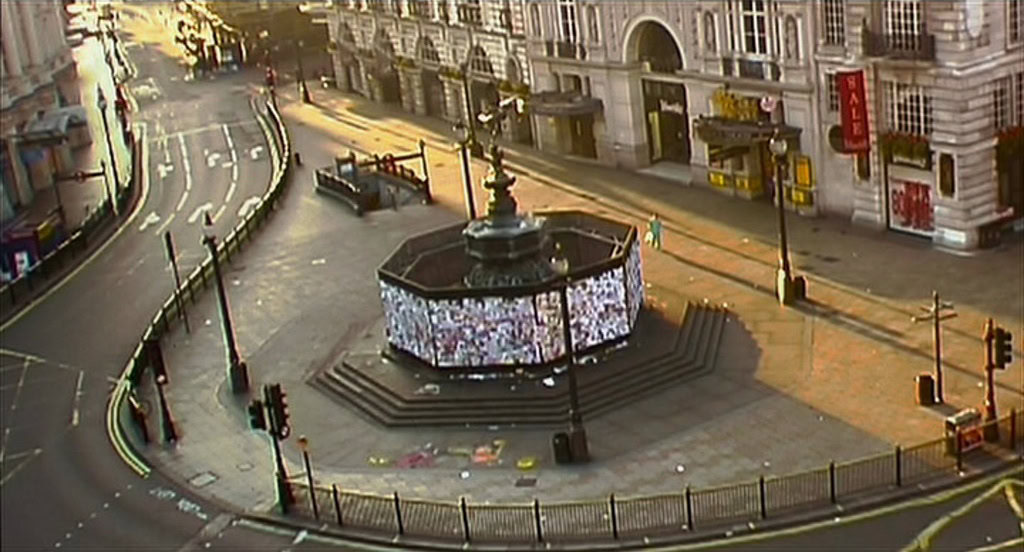
Immediately obvious in his bright green hospital gown, Jim is the only moving object in the frame as he wanders past deserted London landmarks — the very definition of Freud’s Uncanny (i.e. simultaneously familiar and strange). After a couple of nightmarish encounters with the infected, he joins forces with a fellow survivor, the hard-edged Selena (Naomie Harris). She puts the pieces of the disaster together for him:
“Right from the beginning you knew this was different, because it was happening in small villages, market towns. And then it wasn’t on the TV any more. It was in the street outside, it was coming through your windows. It was a virus.”
She warns him there are new rules for living. He must become adept at split-second, deadly decision making. When a companion comes into contact with infected blood or saliva “you’ve got between 10-20 seconds to kill someone.” Selena has been on the streets for 28 days already. She’s ready to kill “in a heartbeat”.
Not all the survivors are as brutal in this new world order. Jim and Selena team up with gentle single dad, Frank (Brendan Gleeson), and his daughter Hannah (Megan Burns). Together, they make the drive north to Manchester searching for the origin of a radio signal promising “the solution to infection”. So much of their journey — the silent Blackwall tunnel, the car free M1 — have a chilling resonance for anyone who has ever struggled with British traffic congestion. These familiar scenes, stripped of cars and people, are utterly sinister.
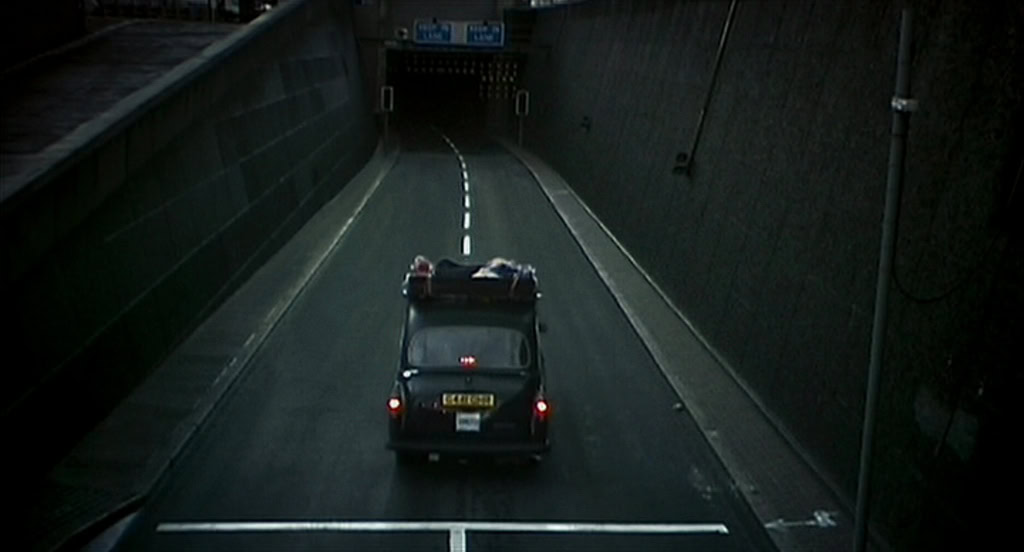
Idyll
Bloodthirsty zombies lurk in every building in this dangerous new world. Even mild-mannered Jim must bludgeon an infected boy to death with a baseball bat. However, it’s also strangely peaceful. For a precious few minutes within the second act, our heroes get some time off the struggle. Once the blight of humanity is removed, England reverts to a green and pleasant land. Horror movies don’t often devote a section of the narrative to this kind of pastoral idyll. Perhaps they should? 28 Days Later shows us a world without humans is quite a nice one.
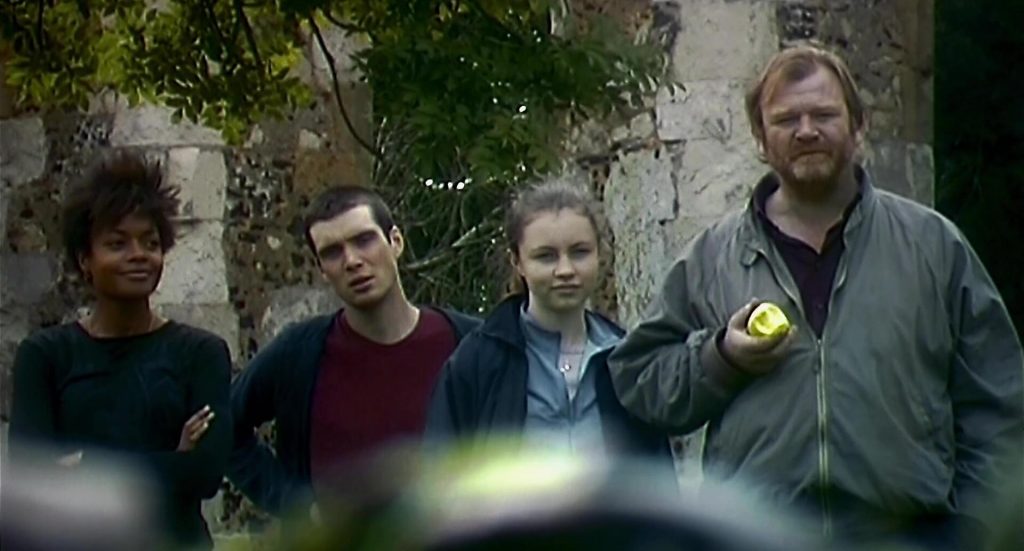
Despite the empty roads, it takes them a couple of days to reach the M62, and they spend the night in the grounds of a verdant ruined castle. Jim, Selena, Frank and Hannah watch a small herd of horses, now wild, galloping through the evening mist. They’re not infected, they’re “doing just fine”. The humans? Not so much. Selena, never one to look on the bright side, tells Jim:
“You’ll never hear another piece of original music ever again. You’ll never read a book that hasn’t already been written, or see a film that hasn’t already been shot.”
They are Omega people, scratching for survival in the ruins of civilisation. Nothing will ever be the way it was. But our survivors, thanks to the civilising relationship between teenage Hannah and her kindly father, behave with courtesy and dignity. Even Selena shows signs of relaxing her guard. She begins to trust and confide in Jim (“I was wrong when I said that staying alive is as good as it gets”).
Unfortunately, the removal of social constraints doesn’t have the same effect on everyone. The source of the “solution to infection” radio signal turns out to be a last outpost, rather than the well-resourced army base they hoped for. A small band of soldiers, led by Major Henry West (Christopher Eccleston) have barricaded themselves into a stately home. Here, they’re rapidly descending into the kind of moral decay familiar to Joseph Conrad. Frank, whose innate decency might have countered the soldiers’ disintegrating morality, is already dead. For very different reasons, Selena, Jim, and Hannah are all lost without him.
Heart of Darkness
The third act of 28 Days Later ratchets up the chill factor with barely a zombie in sight. The infected hordes are kept at bay through technology – tripwires, landmines, floodlights, razor wire (“You wouldn’t want to mow the lawn”). The real threat is human-on-human. Channelling Col. Kurtz, West outlines his vision of the apocalypse to Jim. West has no illusions about calling for help or waiting for rescue. He is the army. He is the end of the line. Consequently, he has all the power.
He feels his duty is to reconstruct, and to that end is recreating feudal society within the old house, based on his rigid sense of army hierarchy. He takes Jim on a tour of the kitchens, where clueless, pinny wearing soldiers clown around, approximating the behaviour of a kindly cook (“Doris”) from another era. West introduces Jim to an infected person, Miller, chained in a side yard. Instead of putting him out of his misery, West wants him under observation. “Eventually, he’ll teach me how long the infected take to starve to death.”
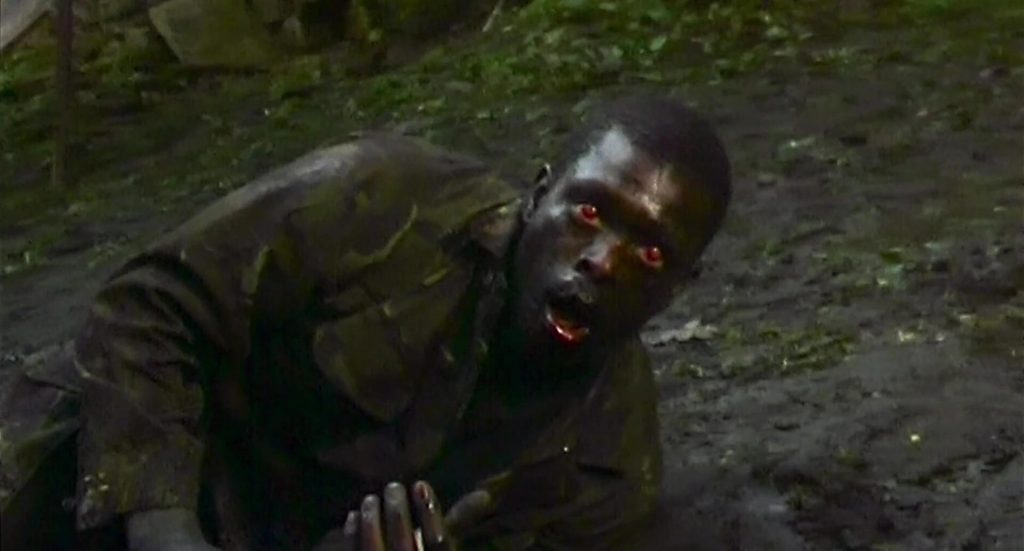
West betrays no trace of compassion towards the suffering of one of his men. He does, however, reveal his megalomania, as he thinks ahead to a time when the infected are all dead, and England is his for the taking. This is reinforced in the next scene, as he presides over a nightmarish dinner party in full dress uniform. He is entirely unperturbed by the current state of affairs. An army man to the core, he regards “people killing people” as Situation Normal: All Fucked Up.
West is also an old-school patriarch, viewing the female characters as objects. He confides to Jim that he promised the soldiers some women as a reward for their loyalty. In West’s new world, Selena and Hannah are simply building blocks. Any objections to West’s plan are quickly stifled: Jim and the “new age sergeant” Farrell, are sent for execution in the woods outside the house – a move straight out of the Brothers Grimm.
Like Hansel and Gretel, or Snow White, Jim survives his trip to the woods, and sees the trail of a jet in the sky. He realises he must oppose West’s inhumanity, and fight for survival in a better world. He’ll shoulder the risk. While Selena and Hannah use all their wits to avert the horror of organised gang rape, Jim launches an attack the best way he knows how, manipulating the infected — the very worst kind of insurgents — and the Manchester rain.
It turns out our soldiers, once separated from their claymores, are not such a well-trained bunch. They’re ill-equipped to deal with the monster inside the house. Darkness and thunderstorm add to the chaos. West’s social experiment rapidly falls apart as the soldiers panic and, thanks to a rampaging Miller, succumb to the virus themselves. A shirtless, soaking Jim peers through the windows at the maelstrom he has created, and is as uncaring as West would be. These are not his people, this is not his way. He has learned that survival is not just about staying alive, it’s about protecting the people and things you believe in. Nothing else matters — even if you have to descend to the same degenerate level as the threat you are fighting.
Happily Ever After?
28 Days Later has three extant endings. The US theatrical release version is upbeat. It suggests our survivors will eventually be rescued, as Britain’s island status has helped contain the infection and the outside world still operates as normal. In an alternate theatrical ending, Jim dies of his wounds, and Hannah and Selena walk into an uncertain future together. This version did not go down well with initial test audiences (although it remains the favourite of the film-makers). Fox Searchlight added this ending as a coda (subbed “… what if?”) to over a thousand prints of the movie. A third version, which never made it past a rough cut, ended with the rescue of just Selena and Hannah.
Impact
28 Days Later delivers the gore and thrills of a horror movie. It also exhibits the control and precision of a plausible sci-fi thriller. The “zombie moments” are few and far between. Instead, the screenplay concentrates on character-building and suspense. Once mass infection is established, the main drama comes from the psychological impact of the situation. 28 Days Later asks universal questions: how would you respond under this kind of extreme, constant pressure? Would you retain your humanity, like Frank? Become ruthless, like Selena? Abandon your moral compass, like Wells? How long would you last?
28 Days Later is a horror movie nonetheless. These characters flee from an ever-present threat. Grand Guignol flourishes in the storytelling refer to fairy tales and other horror movies: the malevolent black crow, straight outta Bodega Bay, responsible for Frank’s death; Hannah and Selena’s red satin ballgowns as they flee through the shadows in the old house; the gore that drips through every frame representing the infected.
28 Days Later has a unique atmosphere, the result partly of the taut script, and partly of the soft-focus, less saturated images generated by digital cameras. Many scenes were shot on a multi-camera set up, using lots of close ups, adding a raw dimension to performances – we are encouraged to respond viscerally to many scenes, not something often demanded of a sci-fi audience. A haunting score by John Murphy highlighting the eerie and the ominous completes the horror experience.
Resonance
Some of 28 Days Later‘s power, unusually for a horror movie, lies in its realism. In some ways, it is the heir to The Blair Witch Project. From the news footage which opens the title sequence — riots, lynching, hangings, sobbing mothers and police brutality — the action is placed firmly in the here and now. This is not Mittel Europe, nor a galaxy far away. The digital footage — the ‘home movie’ effect — only enhances that sensation. Shot in 2001, before the 9/11 attacks, 28 Days Later proved to be uncannily preminiscent, both of familiar cities laid waste by disaster, and of global infection. 9/11 saw the normally crowded streets of New York closed and deserted, and landmarks plastered with “Have You Seen…?” posters.
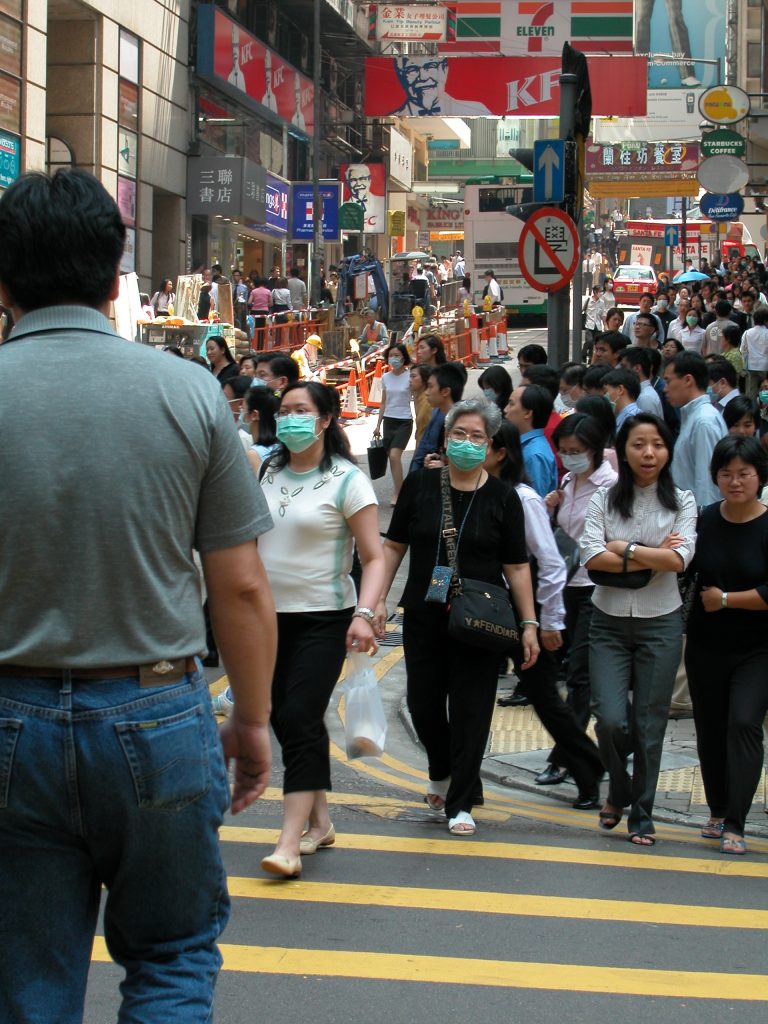
SARS devastated the Hong Kong economy in 2003 as the threat of a new, incurable virus shut schools and public offices, decimated tourism and business travel, and had the whole world wondering if it could happen to them. Whilst SARS receded as a threat, the global medical community is still on standby alert for outbreaks of its close cousin, avian flu. And, although at the time of filming the breakdown of West’s platoon might have been a cultural reference to Vietnam war movies, the representation of soldiers, flailing without any moral compass to guide them, echoed loudly in news stories for the rest of the decade.
Further reading
- Slate – Zombies Ate my Neighbours
- How Did Zombies Get So Fast? Also Slate Magazine
- Bioterrorism and Horror Movies – a set of 2001 predictions which have sadly, not come to fruition
- How 28 Days Later Changed the Horror Genre – Richard Newby in The Hollywood Reporter, June 29, 2018